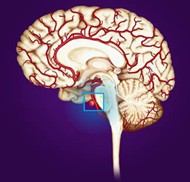 Brain Aneurysm Can Cause Hemorrhagic Strokes |
Hemorrhagic StrokeContents • What Is A Hemorrhagic Stroke? |
Return To Main Article |
What Is A Hemorrhagic Stroke?
There are 2 types of major strokes (images): Ischemic (blockage strokes) and hemorrhagic (bleeding strokes). Ischemic stroke accounts for 80 percent of all strokes and occurs when there is a blockage in an artery supplying blood to the brain resulting in the brain being starved of blood and oxygen. Treatment is aimed at restoring blood flow. Hemorrhagic strokes account for the remaining 20 percent of strokes and occur when a weakened blood vessel bursts and bleeds into the brain. Treatment in this case is aimed at preventing further bleeding and reducing pressure on the brain cells due to excess blood. The bleeding can occur is several different parts of the brain and treatment differs depending on where the bleeding occurs. As brain cells die due to the trauma, they never recover and any function they used to perform in the body is no longer possible. The sooner stroke is treated, the more of the brain that is saved.
Yes, intracerebral hemorrhage (ICH) is the most common type of hemorrhagic stroke. Also called cerebral hemorrhage it occurs when an artery in the brain bursts, flooding the surrounding brain tissue with blood. It usually happens as the result of a cerebral aneurysm (image), a weak spot in an artery in the brain which balloons with blood and eventually bursts. Persistent (chronic) high blood pressure can also lead to weakening of arteries, although a cerebral hemorrhage can also be caused by a head trauma, as in a car accident. The other type of hemorrhagic stroke is called a subarachnoid hemorrhage (SAH). SAH occurs when a blood vessel on the surface of the brain bursts and blood spills into the area between the brain and the thin tissues that cover it (the subarachnoid space). It is usually the result of a ruptured aneurysm or head injury and a severe headache is the most common sign (see also, causes of stroke). ICH is twice as common as SAH and is more likely to result in death or major disability.
Usually symptoms of hemorrhagic strokes progress and worsen over a few minutes to hours as bleeding in the brain gradually causes swelling and pressure (ischemic strokes in comparison occur suddenly). Classic symptoms include: Doctors will seek to take a medical history of the patient from family or care providers to help to identify any possible head trauma cause, although this is difficult if the hemorrhage occurred when the patient was alone or found unconscious. Taking a medical history will also help identify any other factors which predispose someone to ICH such as hypertension (high blood pressure), the use of anticoagulant medications, thrombolytic therapy, heavy alcohol or illegal drug use. Despite the difference between hemorrhagic and ischemic stroke symptoms, brain imaging is still necessary to diagnose which type of stroke has occurred (see stroke diagnosis). A CT or MRI scan will offer this differentiation as well as reveal any structural abnormalities such as an aneurysm or brain tumor. If hemorrhaging is discovered, the location on the brain will help determine the cause and treatment. For example bleeding in the putamen, global pallidum, internal capsule or thalamus is normally caused by hypertension and indicates the immediate benefit of treatment for high blood pressure. Doctors may also use vascular screening, that is ultrasound technology on the neck to check for blockages (sign of ischemic stroke). Medications No: Unlike heart attack treatment where it may be advised to take an aspirin while waiting for emergency services to arrive, this is not a good idea for stroke victims. This is because aspirin can increase bleeding in hemorrhagic stroke patients, worsening the condition. After diagnosis in hospital aspirin may be given to ischemic stroke patients, but it will not be given to hemorrhagic patients. After a stroke it is essential to control your stroke risk factors. However, up until now, most stroke prevention studies have not categorized their studies by stroke subtypes. So while certain lifestyle changes (such as exercising regularly) may help ischemic patients, the effects on hemorrhagic patients are less clear. One study (Elderly Program Study) however did show that maintaining healthy systolic pressure seemed to reduce the risk of ICH by 50 percent. Although this is not considered conclusive evidence it appears that long-term treatment of hypertension is probably the best method for preventing ICH and recurrences. More recently the Framingham Study indicated: Of the estimated 37,000 Americans who experience an ICH stroke every year, 35 to 52 percent were dead within a month. Half of these deaths occurred within the first 2 days of the stroke. Only 10 percent were living independently at month one and 20 percent by month six. See also: Heart disease statistics and stroke recovery.
|
| Related Articles on Hemorrhagic Strokes
For more on vascular health, see the following: Back to Homepage: Womens Health Advice |
|
WOMENS HEALTH ADVICE: ABOUT A STROKE |